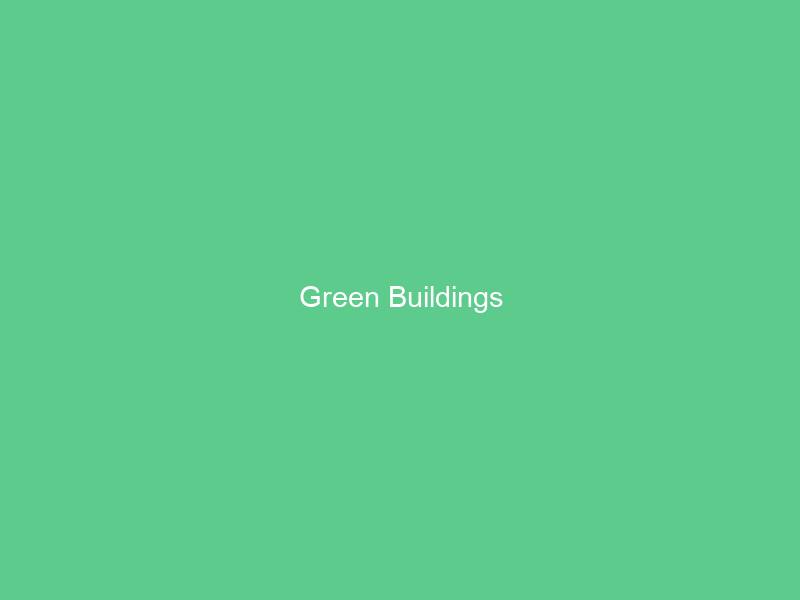Green buildings are environmentally-friendly structures that protect the natural environment by conserving energy, water and other natural resources while increasing biodiversity and creating healthier places to live and work.
Green buildings use premium, long-term materials and utilize sustainable strategies in construction to protect the environment while saving money and increasing property values.
Energy Efficiency
Buildings contribute significantly to global carbon dioxide emissions, energy and water usage and waste production. Green buildings reduce these negative impacts through energy efficiency measures as well as using eco-friendly materials and renewable sources of energy.
Enhancing energy efficiency also results in reduced heating and cooling costs, electricity and natural gas bills as well as green building bills. Innovative technologies, like photovoltaic solar panels that produce on-site power can significantly decrease fossil fuel usage while simultaneously decreasing your footprint on Earth.
Other strategies for energy optimization in green buildings include passive solar design, optimizing daylight and thermal comfort by employing awnings, walls and thermal mass for maximum lighting, using energy-saving appliances and lighting as well as using energy-efficient appliances and lighting. Acoustic comfort factors, including noise levels and reverberation time are also taken into consideration for maximum health and productivity among occupants of green buildings.
Water Efficiency
Green buildings utilize both efficiency and renewable energy sources in order to lower their impact on the environment and local communities. One such approach is xeriscaping, which uses soil improvements and native plants with reduced irrigation needs to significantly decrease water consumption.
Indoors, dual-flush toilets and the use of recycled water can help lower potable water consumption. Green buildings may also incorporate rainwater collection systems that reuse stormwater back to its source or rainwater recycling to decrease potable water consumption.
As global populations and resource scarcity increase, sustainable building practices become ever more essential. Offering practical solutions for climate change and resource scarcity issues, green buildings help create a more responsible future and serve as an example for how communities should look and function going forward.
Indoor Air Quality
Green buildings prioritize indoor air quality (IAQ), which has an impactful and direct relationship to human health and productivity. Poor IAQ can lead to problems including asthma, respiratory illness, depression and stress; furthermore long-term exposure to certain pollutants has been known to cause “sick building syndrome.”
IAQ can be negatively impacted by several factors, including outdoor weather conditions, ventilation rates and occupant behavior. Green buildings prioritize source control to reduce pollution from entering their building; this involves choosing low-emission building materials such as formaldehyde-free plywood and Greenguard Gold-certified paints to limit chemical off-gassing.
Green buildings utilize filtration systems that filter particulate matter, VOCs and mold spores from the air, creating healthier occupants by minimizing exposure. Regular maintenance ensures optimal filtration efficiency resulting in reduced pollutants and healthier residents.
Health & Safety
We spend nearly 90% of our time indoors and the air quality can often be two to five times more toxic than outdoors. Poor ventilation and off-gassing from materials such as pressed wood, paint and furniture may contribute to health problems like watery eyes, headaches and fatigue – green building designs include features to mitigate such risks, making buildings healthier places in which to live and work.
Occupants in green buildings report superior perceived IEQ and self-reported benefits, such as decreased sick building symptoms and higher levels of productivity and wellbeing. Green buildings may also reduce damage from natural disasters through careful siting decisions and passive survivability techniques.
Construction workers can benefit from green building practices as well, with safer and healthier sites helping avoid asbestos exposure or any other hazards on a construction site. This will enhance health and safety on-site as well as potentially make claiming compensation easier should any injuries occur at work.
Environmental Impact
Green buildings are an integral component of sustainable urban development that strives to combat climate change. Green buildings reduce energy use, utilize renewable resources and minimize waste production and emissions.
Many measures used to create sustainable buildings also provide economic benefits. For instance, recycled-content products like pressed wood panels and flooring make use of wood scraps that would otherwise be burnt or sent to landfills, thus cutting back energy consumption and environmental impacts.
Green buildings are designed to benefit local businesses and the environment by using materials sourced locally, which reduces transportation costs and energy use while supporting an economic healthiness. Furthermore, Occupants of green buildings report improved IEQ/health outcomes – including reduced sick building symptoms, enhanced sleep quality and higher work productivity.

